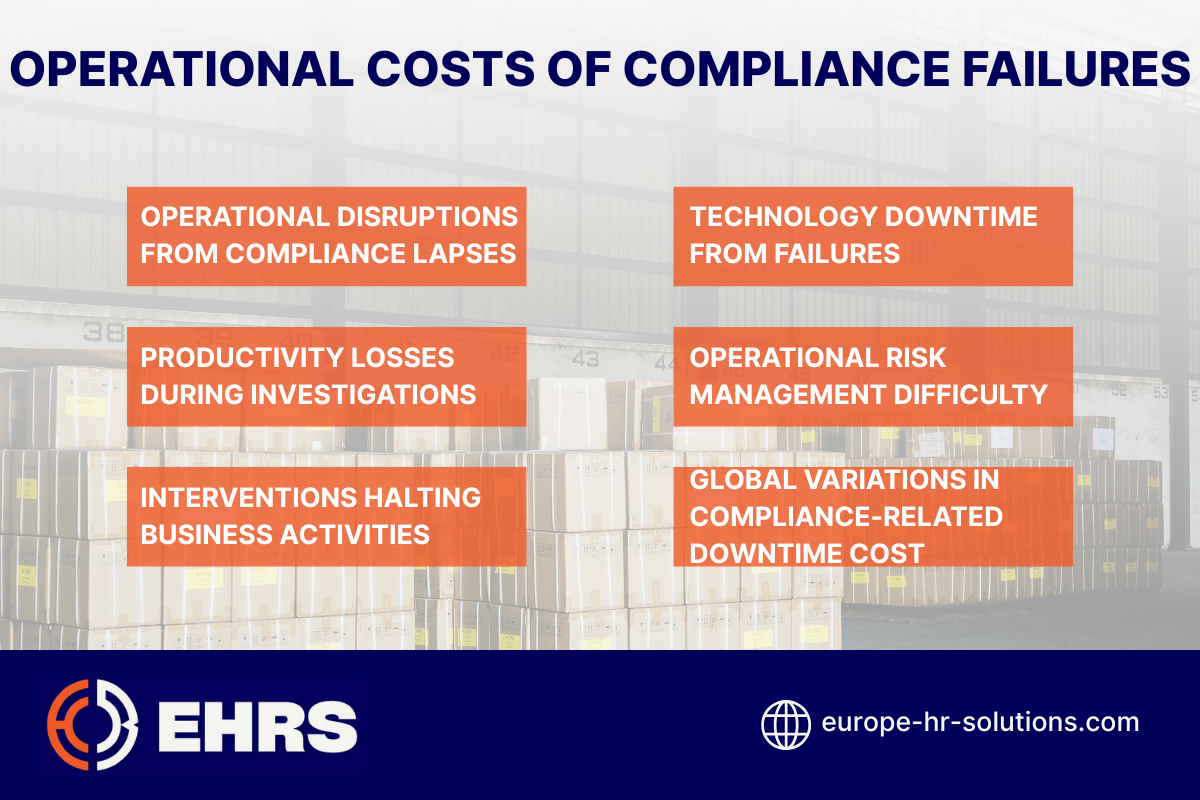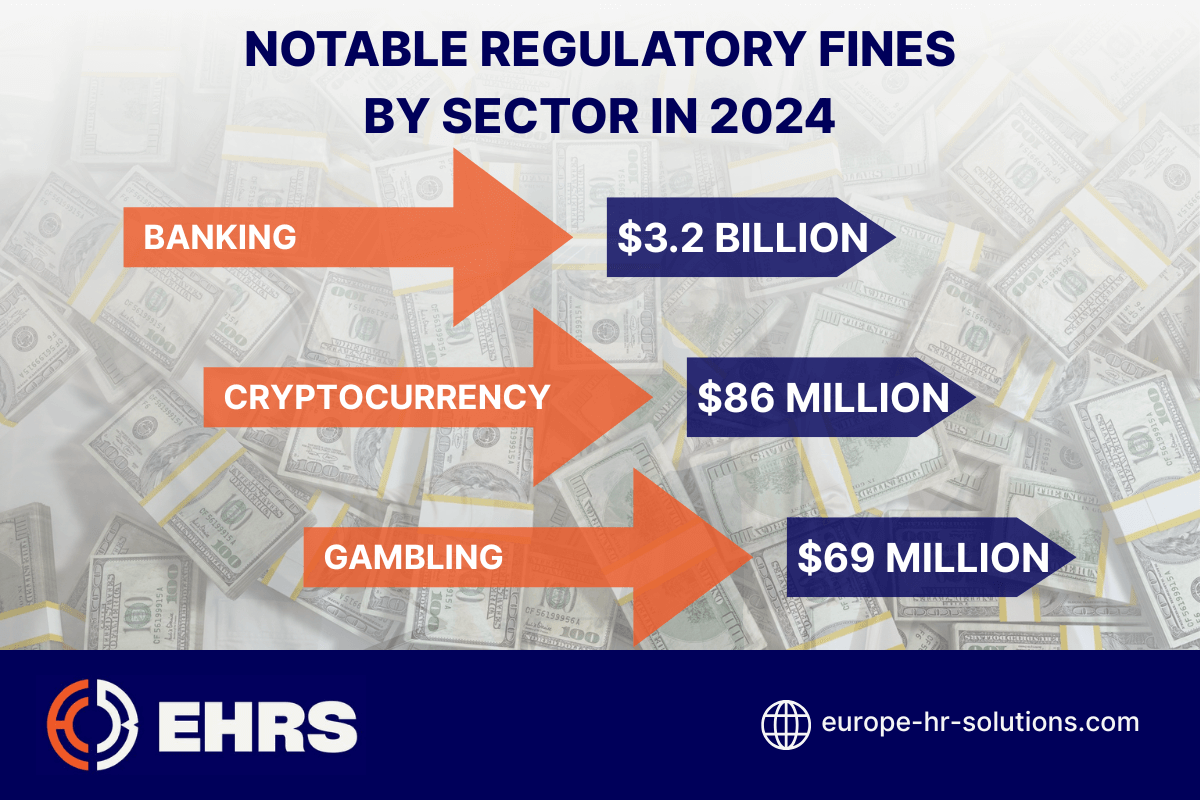Did you know that poor compliance costs businesses millions annually?
Non-compliance with regulations like AML and data protection exposes organizations to financial penalties, reputational damage, and operational disruptions.
This article dissects five critical reasons behind these costs, offering actionable insights to mitigate risks and protect revenue streams while addressing the true cost compliance failures impose on global institutions.
Fines and Penailles: The Direct Financial Impact of Compliance Failures
Introduction to Regulatory Fines and Financial Penalties
Poor compliance costs money through direct financial penalties like regulatory fines. Non-compliance with laws such as AML and data protection exposes organizations to significant monetary losses. JP Morgan’s $125 million fine in 2021 highlights the immediate consequences of violating compliance protocols, emphasizing the need for robust regulatory adherence.
JP Morgan’s $125 Million Fine in 2021
In 2021, JP Morgan faced a $125 million fine from the SEC and CFTC for employees using unapproved platforms like WhatsApp. This breach overlooked federal data retention rules, showcasing how poor compliance costs money through legal repercussions. The case underscores the financial risks of bypassing compliance frameworks.
Major Financial Penalties Across Industries
Notable Regulatory Fines by Sector in 2024
| Sector | Total Fines in 2024 (USD) | Key Violations |
| Banking | $3.2 billion | Outdated compliance programs, failure to file SARs, employee involvement in financial crime |
| Cryptocurrency | $86 million | Ineffective transaction monitoring systems enabling $9 billion in suspicious payments |
| Gambling | $69 million | Casino money laundering via high-risk clients and inadequate risk-based filtering |
Increasing Regulatory Fine Amounts Over the Past Decade
Regulatory fines have surged globally, with the Ponemon Institute reporting non-compliance costs at $14.82 million versus $5.47 million for compliance. IBM notes a 45% rise over ten years, showing poor compliance costs money through escalating penalties. This trend underscores the financial imperative for stricter compliance measures.
AML Compliance Failures and Substantial Penalties
AML violations trigger severe penalties, exemplified by Goldman Sachs’ $2.9 billion 1MDB scandal fine. Global AML spending is projected to hit $51.7 billion by 2028, reflecting how poor compliance costs money through fines and operational overhauls. Regulatory bodies prioritize AML enforcement to deter financial crime.
Global Variations in Financial Penalty Structures
Penalties for non-compliance differ geographically, with the U.S. imposing strict AML penalties via FinCEN. HSBC and BNP Paribas faced $1.9 billion and $8.9 billion fines, respectively, illustrating how poor compliance costs money globally. Regional regulatory rigor, like Europe’s focus on sanctions, amplifies financial risks for non-compliant businesses.
Legal Expenses: The Hidden Burden of Non-Compliance
Overview of Legal Costs in Compliance Failures
Non-compliance with regulations like AML and data protection leads to significant legal expenses. In 2018 alone, non-compliant organizations paid $3.945 billion in penalties. The average cost of non-compliance rose to $14.82 million, far exceeding proactive compliance investments. Poor compliance costs money through litigation, settlements, and operational disruptions.
Capital One’s $190 Million Class Action Settlement
In 2019, Capital One faced a $190 million settlement after a data breach exposed 106 million customers. A misconfigured firewall allowed unauthorized access to sensitive data. This incident highlights how poor compliance costs money through costly legal resolutions. Strengthening cybersecurity protocols could have prevented this financial burden.
Attorney Fees and Compliance Investigation Costs
Legal defense for compliance investigations averages €900 per day in Europe, with GDPR-related cases reaching €25,000 for mid-sized companies. These fees cover audits, regulatory negotiations, and policy overhauls. Poor compliance costs money as legal expenses escalate during enforcement actions and settlements.
- Direct fines from regulatory violations
- Legal defense and litigation fees
- Settlement payments for breaches
- Post-violation remediation and compliance upgrades
Long-Term Legal Monitoring After Resolutions
Post-settlement compliance monitoring lasts 2–5 years, costing €900 daily for consultants. Financial institutions face recurring audits and reporting obligations. Poor compliance costs money through sustained legal oversight, diverting resources from core operations to meet regulatory demands.
Financial Institutions’ Unique Legal Vulnerabilities
Financial firms spend $18 million annually on cyberthreats, 40% more than other sectors. AML regulations like the Bank Secrecy Act impose strict reporting. Non-compliance triggers penalties like Deutsche Bank’s $630 million fine in 2020. Poor compliance costs money through sector-specific legal exposure to sanctions and fraud.
Business Disruption: Operational Costs of Compliance Failures

Operational Disruptions from Compliance Lapses
Non-compliance with cybersecurity and data protection standards disrupts core operations. The 2024 CDK Global ransomware attack paralyzed 15,000 car dealerships for two weeks, costing $1.02 billion in lost sales. Departments like sales, customer service, and inventory management faced operational standstills, highlighting how poor compliance costs money through productivity losses and revenue gaps.
Productivity Losses During Compliance Investigations
Compliance investigations divert employee focus from primary tasks. At CDK Global, 56,000 car sales vanished as staff prioritized crisis management over customer engagement. Human resources and compliance teams spent 80% of their time on remediation, illustrating how poor compliance costs money by stalling revenue-generating activities and inflating labor inefficiencies during regulatory scrutiny.
Regulatory Interventions Halting Business Activities
The CDK Global breach forced manual operations for 15,000 dealerships, costing $1.02 billion in lost transactions. Regulatory interventions often suspend critical functions until vulnerabilities are addressed, showing how poor compliance costs money through revenue freezes, contractual penalties, and long-term operational recovery expenses that strain financial stability.
Technology Downtime from Compliance Failures
Cybersecurity lapses trigger costly system outages. A healthcare provider’s ransomware attack caused server downtime, losing $450,000 in billable hours. IDC estimates average downtime costs at $260,000 per hour, proving how poor compliance costs money through disrupted technology infrastructure and lost revenue during critical operational windows.
Operational Risk Management Difficulty Post-Compliance Incidents
Post-incident, firms implement stricter controls and reporting systems. 53% of compliance officers face board pressure to improve protocols, while non-compliance costs 2.6x more than proactive measures. This illustrates how poor compliance costs money through resource-intensive risk management overhauls and sustained operational inefficiencies.
Global Variations in Compliance-Related Downtime Costs
Regional enforcement differences exacerbate financial risks. U.S. companies face average $260,000/hour downtime costs versus $180,000/hour in Europe. HSBC’s $1.9 billion fine and BNP Paribas’ $8.9 billion penalty show how poor compliance costs money through geographically inconsistent penalty structures and operational adaptation expenses.
Reputational Damage: The Long-term Financial Impact
Compliance Failures and Brand Reputation Erosion
Non-compliance with data protection laws damages brand reputation and customer trust. The CDK Global ransomware attack disrupted 15,000 car dealerships, triggering lawsuits for privacy breaches. A study shows brand image influences up to 33% of annual profits, proving poor compliance costs money through eroded trust and market value declines.
Reputational Losses in Non-Compliance Costs
Reputational damage accounts for 32% of non-compliance losses, though exact calculation methods remain unclear. While sources vary, this figure underscores the financial weight of brand erosion. Poor compliance costs money by alienating stakeholders and reducing market capitalization long after initial penalties are paid.
Stock Value Declines After Compliance Scandals
Major compliance scandals correlate with stock price drops. Wells Fargo’s 0.69% single-day decline after a money laundering investigation mirrors Ponemon Institute findings: non-compliance costs $14.82M vs. $5.47M for compliant firms. Poor compliance costs money by spooking investors and destabilizing shareholder confidence.
Customer Attrition from Data Protection Failures
British Airways’ 2018 breach exposed 429,612 customers’ data, costing $26M in fines and customer loss. Yahoo’s $350M acquisition discount after a breach highlights how poor compliance costs money through eroded consumer loyalty. Sixty-six percent of Americans distrust companies after data leaks, per studies.
Financial Institutions’ Reputational Vulnerability
Financial firms face heightened reputational risks due to trust-based business models. PwC reports 64% of major sanctions come from financial non-compliance. HSBC’s £64M 2021 fine for transaction monitoring failures illustrates how poor compliance costs money through regulatory retaliation and long-term client attrition.
Global Enforcement and Reputational Fallout
Regional enforcement disparities amplify financial risks. U.S. banks face stricter penalties than European counterparts, with HSBC and BNP Paribas paying $1.9B and $8.9B fines respectively. Poor compliance costs money by triggering jurisdiction-specific reputational damage and cross-border operational challenges for global institutions.
Poor compliance isn’t merely a regulatory hurdle—it’s a financial sinkhole draining resources through fines, reputational damage, and operational disruptions. Proactive compliance investments—in training, audits, and tech-driven solutions—transform risk management from a cost center to a strategic safeguard. The real price of non-compliance isn’t in penalties alone but in the irreversible loss of trust, revenue, and long-term resilience—a lesson no business can afford to learn twice.
Frequently Asked Questions (FAQ)
What is the meaning of poor compliance?
Poor compliance, or noncompliance, signifies a failure to adhere to rules, regulations, or requirements. This can manifest in various ways, from not following medical instructions to violating legal standards. The essence of poor compliance is a deviation from what is expected or mandated.
Several factors contribute to noncompliance, including lack of knowledge, adverse effects of treatments, or complex requirements. The consequences can be significant, leading to relapses, legal ramifications, and reputational damage. Strategies to improve compliance include simplifying regimens and enhancing education.
What are the hidden costs of non compliance?
The hidden costs of non-compliance extend far beyond initial fines and penalties, significantly impacting a business’s long-term health. These costs include operational delays, increased insurance premiums, and reputational damage. Operational disruptions can lead to lost revenue and damaged client relationships, while higher insurance premiums reflect a heightened risk profile.
Furthermore, non-compliance can result in legal fees, settlements, and decreased staff morale. Reputational damage erodes trust among customers and stakeholders, leading to business losses and a decline in stock value. The total cost of non-compliance, encompassing these factors, can exceed $14 million.
Is noncompliance illegal?
The legality of noncompliance hinges on the specific context and relevant laws or regulations. In many instances, noncompliance is indeed illegal, triggering financial penalties, lawsuits, reputational harm, and business interruptions. For example, violating securities laws or environmental regulations can lead to severe fines and legal action.
However, in some cases, noncompliance might not be inherently illegal but still carries negative consequences. Failure to adhere to internal company policies can result in disciplinary measures or termination. Ultimately, understanding compliance obligations and proactively meeting requirements is crucial to avoid significant legal and financial repercussions.

![5 Reasons Poor Compliance Costs Money [Case Studies + Data] FI 5 Reasons Poor Compliance Costs Money [Case Studies + Data] FI](https://europe-hr-solutions.com/wp-content/uploads/2025/09/5-Reasons-Poor-Compliance-Costs-Money-Case-Studies-Data.png)




